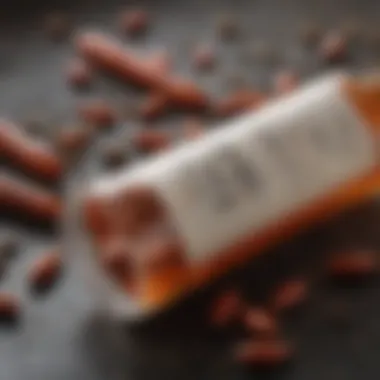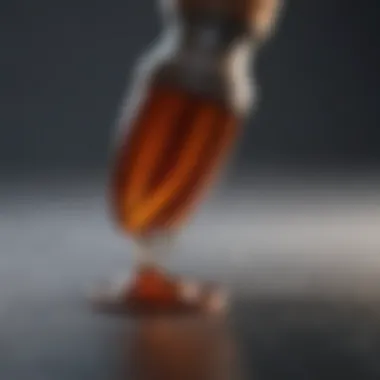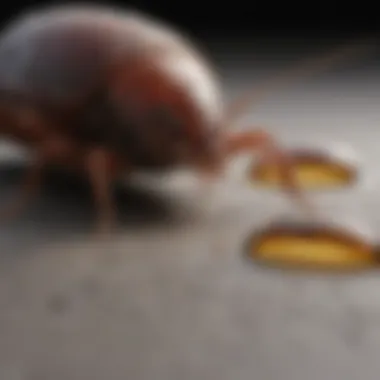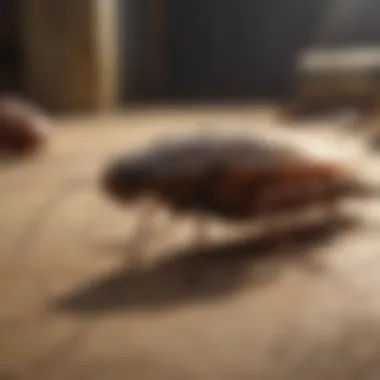Understanding the Best Roach Gel for Pest Management


Intro
In this guide, we will delve into pest identification first, which is crucial to effectively combatting these unwanted guests. Following that, we will detail prevention strategies that every homeowner can implement. Finally, we will evaluate treatment options, including the various roach gels available on the market and their effectiveness.
Throughout the text, we aim to provide practical insights to equip our readers with the necessary tools. It is essential to choose the right products and apply them correctly to achieve long-lasting results in pest management.
Pest Identification
When it comes to pest control, understanding the enemy is the first step. Roaches are notorious for being resilient. Recognizing the species and their behaviors can dictate an effective response.
Detailed descriptions of common pests
Most common species include the German roach, American roach, and Oriental roach.
- German Roach: Small in size, about half an inch long. They are light brown with two dark stripes running lengthwise down their backs. They often thrive in kitchens and bathrooms due to warmth and moisture.
- American Roach: A larger pest, about two to four inches long, reddish-brown in color, with a yellowish figure on the thorax. They prefer dark, moist areas and can be found in basements or sewers.
- Oriental Roach: This species is glossy black and about an inch long. Known for their ability to withstand colder temperatures, they are often found in damp basements.
Signs and symptoms of infestations
Identifying an infestation early on is crucial. Look for these signs:
- Droppings: Small, dark pellet-like droppings are a telltale sign.
- Egg Casings: These casings, also known as oothecae, are reddish-brown and found near hiding spots.
- Strong Odors: An unpleasant smell in infested areas can indicate a problem.
"The earlier you spot signs of an infestation, the easier it is to control it."
Roaches are resilient and can multiply quickly. Knowing their signs helps in managing an infestation before it escalates.
Prevention Strategies
Preventing a roach infestation is often more effective than treatment after the fact. Implementing basic home maintenance and utilizing natural deterrents can significantly reduce the chances of a roach problem.
Home maintenance tips for pest prevention
- Seal Cracks and Gaps: Inspect areas around pipes, doors, and windows for openings and seal them.
- Maintain Cleanliness: Regularly clean kitchens, ensuring no food particles are left out.
- Proper Waste Management: Use sealed trash cans and dispose of garbage regularly. This reduces attractants.
Natural deterrents and barriers
Some natural methods can serve as barriers to roaches:
- Boric Acid: While it is a chemical, it is less toxic than many commercial products.
- Baking Soda: Mixed with sugar, it can attract roaches and cause dehydration.
- Essential Oils: Scents like peppermint and eucalyptus might deter roaches. Consider placing diluted oils in spray bottles for a natural repellent.
By focusing on prevention, homeowners can create an environment less inviting for roaches, making future infestations less likely.
Treatment Options
Even with the best preventative approaches in place, treatments may sometimes be necessary. Understanding the types of treatments available can aid in effective pest management.
Overview of chemical vs. natural treatments
Chemical treatments often include roach gels, which are specifically designed to attract and kill roaches over time. On the other hand, natural treatments focus on less toxic methods, usually aimed at repellent effects or disrupting nesting behaviors. Each has its place based on the severity of the infestation and personal preferences regarding chemical use.
Step-by-step guides for DIY treatments
Effective DIY treatment can be structured as follows:
- Identifying the Infestation: Understanding the scope is critical. Use traps to gauge the level of infestation.
- Choosing the Right Product: Select a roach gel that suits your needs. Brands like Advion and Maxforce are popular choices for their efficiency.
- Application: Apply the gel in areas where roaches are commonly seen or are suspected to be hiding.
- Monitoring Progress: Regularly check and replace the gel as needed. Over time, you will notice a decline in roach activity.


Understanding the different approaches to pest management will help maintain pest-free living spaces. Evaluating the effectiveness of the roach gels can offer more significant insights into integrated pest management strategies.
In summary, being informed about roach identification, preventive measures, and treatment options empowers homeowners to manage pest issues effectively. This guide serves as a foundation to ensure you have the knowledge necessary for effective pest control.
Prolusion to Roach Gels
Roach gels serve a critical role in pest management strategies. They provide an effective method for controlling cockroach populations in residential areas. Homeowners often seek effective solutions to prevent, manage, and eliminate roach infestations. Roach gels are among the leading products offered on the market today.
The importance of roach gels lies in their efficacy and ease of use. Unlike traditional sprays or traps, gels can penetrate places that are difficult to reach. They appeal to roaches and allow for effective baiting. Furthermore, they tend to be low in toxicity when applied correctly, promoting safety for humans and pets in the living environment.
The Role of Roach Gels in Pest Control
Roach gels are designed specifically to attract and poison cockroaches. The appeal to roaches comes from the gel's composition, which mimics food sources. This targeting is a significant advantage over general pesticides. When a cockroach consumes the gel, it may die within a few days. During this time, it can share the toxic agent with others through feces or saliva, effectively spreading the control measure throughout the population.
Additionally, roach gels do not create immediate disturbances like sprays do. This allows homeowners to use them without major disruption to daily life. They can discreetly place the gel in corners, under sinks, and also behind appliances without drawing attention. A strategic placement can maximize contact with the targeted pests.
"Proper placement of roach gel can enhance its effectiveness. Consider high-traffic areas commonly inhabited by cockroaches."
Understanding Cockroach Behavior
To effectively utilize roach gels, one must comprehend cockroach behavior. Cockroaches are nocturnal insects, meaning they are mostly active during the night. They are attracted to warmth, moisture, and food sources, which they can find in kitchens and bathrooms. Knowing this can aid in determining the best locations for applying roach gels.
Another essential behavior is their social nature. They often return to the same locations, leading to repeated exposure to toxicants. This reinforces the need for a consistent application of gel in key areas. Monitoring these sites will help to gauge the effectiveness of the treatment.
In sum, understanding the behavior of cockroaches is paramount for anyone looking to implement roach gels into their pest management strategy. Effective utilization of these gels can lead to a more substantial and longer-lasting impact on pest populations.
Criteria for Choosing Roach Gels
Selecting the right roach gel is essential for effective pest management. When considering the most suitable options, several criteria come into play. Each factor plays a significant role in ensuring that the chosen product not only effectively targets cockroaches but also aligns with safety and practical usability for the household. Understanding these criteria assists homeowners and renters in making informed decisions that lead to successful pest eradication.
Active Ingredients Overview
The efficacy of a roach gel largely depends on its active ingredients. Commonly used ingredients include fipronil, imidacloprid, and hydramethylnon. Each of these compounds works differently to disrupt the life cycle of cockroaches.
- Fipronil: This ingredient affects the central nervous system of the insect, leading to paralysis and eventual death.
- Imidacloprid: This chemical targets the nervous system as well but has a different mode of action that can be particularly effective against certain species.
- Hydramethylnon: Often delays the growth of cockroaches, disrupting their ability to reproduce, which is crucial in controlling their population.
It is important to read the label carefully. The concentration of active ingredients can indicate how potent a gel may be and determine the level of infestation it can handle. Always consult a pest control expert if unsure about which active ingredient would be most effective for your specific needs.
Safety and Toxicity Concerns
Safety is paramount when using any pest control product, especially in households with children and pets. Many commercial roach gels tout safety features, yet it is vital to critically assess these claims. Look for products free from harmful chemicals or those marked as low toxicity.
Consider the following regarding safety:
- Childproof Packaging: Ensure the product comes in containers that are difficult for children or pets to open.
- Non-repellant Formulas: Some gels attract roaches without posing significant risks to human health when used as directed.
- Odor: Some gels emit strong odors. Choose low-odor products to mitigate discomfort in your home.
It is also prudent to follow application instructions with precision to maximize safety. Ventilation and appropriate protective gear, like gloves, should be part of the application process to minimize exposure.
Application Method and Ease of Use
The effectiveness of roach gels also hinges on how easily they can be applied. Choosing a product that is straightforward to use can significantly enhance the pest control experience.
Consider the following:
- Syringe Applicators: Many roach gels come with an applicator that allows for targeted placement in cracks, crevices, or areas where roaches frequent.
- Cleanup: Choose gels that do not leave a sticky residue, as this can make the application area less hygienic.
- Visual Guides: Some brands provide step-by-step application instructions or video tutorials, which can help ensure users apply the gel correctly.
Overall, the ideal roach gel should blend effectiveness with ease of application. Careful selection based on these criteria will contribute immensely to a successful pest management strategy.


Comparison of Top Roach Gels
When considering effective pest management, the comparison of top roach gels is essential. Selectin the right gel plays a crucial role in ensuring that the chosen product aligns with your specific needs and environment. With numerous options on the market, each with unique characteristics, understanding these differences can lead to more effective extermination.
There are several facets to consider when comparing these products. These include active ingredients, methods of application, and overall effectiveness. Notably, the influential factors are:
- Active ingredients: Different gels utilize distinctive insecticides. Knowing these can affect safety, usage, and efficiency.
- Application techniques: Some gels may be easier to apply or have detailed instructions. This directly impacts pest management efforts.
- Customer experiences: Reviews often provide insight into real-life effectiveness, allowing users to gauge reliability.
Evaluating these aspects not only supports informed decision-making but also enhances the efficacy of pest control measures you execute in your home.
Gel A: Key Features and Benefits
Gel A, known as Advion Cockroach Gel, stands out in several ways. One prominent feature is its active ingredient, indoxacarb. This ingredient works by affecting the nervous system of cockroaches, leading to their demise after ingestion. Moreover, this gel is highly attractive to many species of roaches.
Some key benefits include:
- Fast-acting formulation: Users report seeing results within the first few days.
- Long-lasting effect: The residual effectiveness can persist for up to three months, reducing the need for frequent applications.
- Broad-spectrum attraction: Its formulation targets numerous species, making it versatile for varied infestations.
These features make Gel A a popular choice among homeowners.
Gel B: Effectiveness and Customer Reviews
Gel B, referred to as Maxforce FC Roach Gel, is notable for its effectiveness as well. Reviews consistently highlight its potent action against stubborn cockroach populations. Users emphasize their satisfaction with both immediate and long-term results.
Highlights of customer feedback include:
- Quick kills: Many reviewers note that infestations dwindled rapidly after application.
- Ease of application: The gel comes with a applicator tip that simplifies placing it in hard-to-reach areas.
- User-friendly: Customers appreciate clear instructions, making it accessible to those less experienced in pest control.
Such testimonials underscore why Maxforce FC continues to hold popularity in the pest control market.
Gel C: Price vs. Performance
Gel C, named Hot Shot Bed Bug and Roach Killer, serves as an important case study of price versus performance. While some options can become quite costly, this product is often lauded for its affordability without sacrificing effectiveness.
Key aspects to consider:
- Cost-effective: Generally priced lower than competitors while still achieving favorable results.
- Adequate performance: Though it may not be as potent as pricier gel options, it still delivers satisfactory outcomes for the average user.
- Simple ingredients: Consumers may prefer straightforward formulations that still offer good efficacy.
How to Apply Roach Gel for Maximum Effectiveness
Applying roach gel correctly is crucial for its success in pest management. This section details essential practices to enhance effectiveness. Proper application ensures that the gel targets cockroach habitats efficiently, making it harder for them to thrive.
Preparation of the Area
Before using roach gel, it is necessary to prepare the application area. Start by cleaning the space. Remove food, crumbs, and debris, as these can attract cockroaches. Wash counters and floors to eliminate scent trails that may lead roaches back. Secure food items in containers or the refrigerator. Next, inspect for any existing signs of cockroach activity. Look for droppings, egg cases, or shed skins. Awareness of the infestation areas helps in placing the gel strategically.
Application Techniques
The method of applying roach gel matters significantly. Use a small amount, typically a pea-sized drop, in strategic locations. Focus on cracks, crevices, near appliances, and under sinks where cockroaches hide. Ensure not to apply in areas with direct water exposure, as moisture can reduce the gel's effectiveness. Additionally, avoid visible spots; cockroaches prefer hidden areas.
- Use a syringe. Many products come with a syringe or nozzle for precision application.
- Avoid over-application. Too much gel can lead to waste and may also deter cockroaches.
- Regularly check the applied areas. Check and replenish the gel as needed, particularly if it appears to have dried out or been consumed.
Frequency and Timing of Application
Applying roach gel requires consideration of timing. For effective pest management, apply roach gel strategically.


- Initial application should be done in early evening, as cockroaches are nocturnal. This timing maximizes their potential to encounter the gel.
- Reassess regularly. Every week, check the application spots. If you notice less activity, the gel likely needs replenishment.
- Follow up after some weeks for ongoing protection. Even if roach activity seems reduced, doing periodic applications can be beneficial to keep potential populations in check.
By understanding and utilizing these application techniques, homeowners can maximize the effectiveness of roach gel and enhance their pest management strategy. Proper application can significantly influence the success of eradicating cockroaches from your home.
Integrating Roach Gel into an Overall Pest Management Strategy
Integrating roach gel into an overall pest management strategy is crucial for ensuring long-lasting pest control. This approach involves not only the application of the gel but also the incorporation of various complementary methods that work together to eliminate cockroaches effectively. It focuses on creating an environment that is less conducive to pest infestations. The combination of techniques enhances the effectiveness of roach gels. This matters greatly for homeowners who seek sustainable solutions for pest issues.
Complementary Pest Control Measures
When using roach gel, it is important to utilize additional pest control measures. These can include:
- Regular Cleaning: Keeping living spaces clean is essential. Remove food particles and crumbs, which can attract cockroaches. This simple step can reduce the chances of an infestation.
- Sealing Entry Points: Inspect your home for cracks, gaps, or any openings. Sealing these entry points helps to prevent roaches from entering. Use caulk or appropriate materials for this task.
- Using Traps: In addition to gels, traps can capture roaches and monitor their population. These will reassure you that the gel is working, and help track roach activity.
- Environmental Management: Reduce clutter and maintain proper moisture levels in the home. Cockroaches prefer damp places. Fix leaky pipes and ensure good drainage to limit these habitats.
Monitoring and Maintenance
After integrating roach gel into your pest control strategy, continuous monitoring is vital. It helps to evaluate the effectiveness of your management approach. Here are some effective practices:
- Regular Inspections: Check areas where you applied the gel to spot any new roach activity. Inspect under sinks, appliances, and in cabinets as these are common roach hiding places.
- Adjusting Frequency of Applications: Depending on your observations, you may need to reapply the gel. If you see increased roach sightings, this may indicate the need for additional applications.
- Collaboration with Pest Control Professionals: Consider hiring pest control experts if the problem persists. Their knowledge can enhance your current strategies.
"Effective pest management is not a one-time effort; it requires ongoing monitoring and adjustments to ensure success."
Maintaining vigilance ensures that the roaches do not make a comeback. This ongoing commitment helps create a safer, more comfortable living environment.
Common Myths About Roach Gels
Myths surrounding roach gels can mislead homeowners and affect their pest control efforts. Addressing these misconceptions is necessary to clarify how these products truly work and what users can expect from them. Understanding the common myths can empower individuals with the right knowledge to make informed decisions about pest management and preventative measures.
Effectiveness Myths
One prevalent myth is that roach gels are ineffective against large infestations. While it is true that a heavy population of cockroaches may require a more comprehensive approach, roach gels do play a significant role in managing and eliminating these pests. The gel attracts roaches, leading them to feed on the active ingredients, which typically contain a slow-acting poison. This allows affected roaches to return to their nest, where they can spread the poison to others, effectively diminishing the population over time.
Another misconception is that roach gels work instantly. Users might expect to see immediate results, but it can take several days to observe a reduction in activity. Patience is vital when using these gels, as they depend on the roaches feeding on them. It’s also essential to recognize that different species of cockroaches may respond at varying rates to the active ingredients used in the gels.
Safety Misunderstandings
Safety is often a concern for those considering using roach gels, leading to various misunderstandings. Many assume that all roach gels are toxic and hazardous. While some products can pose risks if misused, many reputable brands formulate their gels with safety in mind. The active ingredients are often designed to minimize harmful effects on humans and pets while effectively targeting roaches.
Parents with young children or pets may worry heavily about the presence of any chemicals within the home. It is essential to follow the product’s safety instructions. Placing the gel in areas that are out of reach can alleviate most concerns. Moreover, many gels are designed to dry quickly, reducing the chance of accidental ingestion.
"Understanding the myths about roach gels is critical to effective pest management, as these misconceptions can lead to ineffective strategies and unnecessary frustration."
Finally, some believe that roach gels are only for severe infestations and that preventative measures are unnecessary. This is misleading because using roach gels proactively can help maintain control and prevent infestations before they occur. Regular application in strategic locations can create a barrier of protection against these resilient pests.
The End: Selecting the Best Roach Gel
Selecting the right roach gel is crucial for effective pest management. This choice involves various factors, including active ingredients, application methods, and safety precautions. The effectiveness of a roach gel can vary significantly based on these elements. As we examined throughout this article, understanding cockroach behavior and engaging in complementary pest control measures are essential.
When choosing a gel, consider how the gel’s formulation interacts with roach habits. A product that attracts and efficiently delivers poison to the roaches can significantly alter their population dynamics in your home. Combining this knowledge with practical application methods amplifies the effectiveness of the treatment.
By prioritizing safety and ease of use, homeowners can ensure that they are handling pest control responsibly. Proper knowledge will guide decisions to select gels that not only yield results but also promote healthy living environments.
"Awareness of the unique properties of various roach gels is vital for achieving long-term pest control success."
Final Recommendations
- Examine Ingredients: Look for gels that contain effective active ingredients such as fipronil or hydramethylnon. These have been shown to provide consistent results against cockroach infestations.
- Assess Safety Measures: Prioritize gels labeled as safe for indoor use, especially in homes with children or pets. Always read the instruction labels carefully.
- Evaluate Product Reviews: Customer feedback can provide insight into which gels work best under different circumstances. Pay attention to reviews that discuss real-life situations.
- Consider Application: Opt for gels that are easy to apply. Products with precision tips can help target specific areas without creating messes.
Looking Ahead: Future Innovations in Pest Control
The field of pest control is evolving rapidly, with constant research leading to the development of innovative solutions. Here are some potential future directions for roach gel technology:
- Biological Solutions: Researchers are looking into biological pest control methods that are eco-friendly and target specific pests without harming beneficial insects.
- Smart Pest Control Systems: Integration of smart home technology could lead to devices that monitor roach activity and dispense gel automatically when infestations are detected.
- Advanced Formulations: Innovations in active ingredients could lead to more effective gels that work faster and with minimal toxicity.
- Sustainability Focus: Increased consumer demand for sustainable products may foster the creation of roach gels made from natural substances without compromising efficacy.
By staying informed and adapting to new technologies, homeowners can maintain effective pest management strategies in the face of evolving pest behavior.



